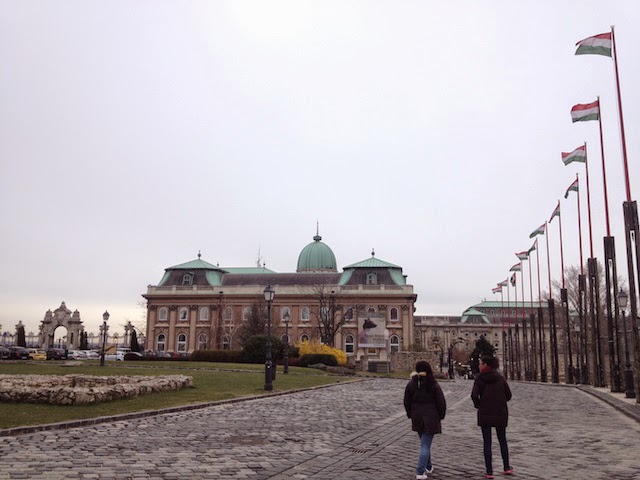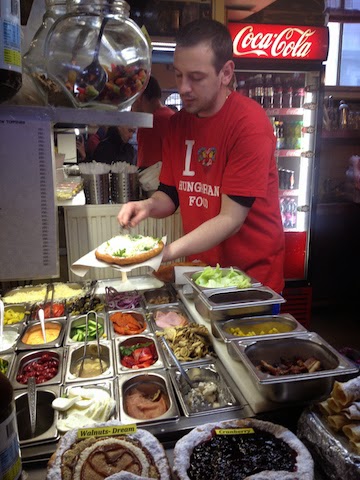Now for the last day of my Spring Break trip... The next morning we headed to the
Buda Castle Hill, yet another UNESCO World Heritage Site in Budapest. From the previous day's experience, we decided to take public transportation so as not to tire ourselves out too much, so we wouldn't have to walk in the cold, and to save time (since Lyle had to leave by noon).
A bit of a note about the public transportation in Budapest: like Prague, Budapest has a metro, trams, and buses. But unlike Prague, a ticket is only valid for 1 uninterrupted journey, i.e. you can't switch from metro to tram (or metro to bus, etc.). It's a bit of a hassle, especially if your destination can't be reached via one mode of transportation. A single ticket costs
350 huf (about €1.20). The day before, we had bought a block of 10 tickets which costs 3,000 huf - so each ticket came out to 300 huf - and we used 3 of them for our metro back home. We were calculating how many we'd need that day (metro + bus to Castle Hill and back - at least 4), when Julie and I decided to just get the 24 hr travel card (and Lyle bought off from us the rest of the tickets from the 10 block). The
24 hr travel card costs
1,650 huf - which means you just need to take 5 rides to make the card
sulit (and we were already taking 4 just to get to Castle Hill and back). It turned out to be the best decision we made. Haha. Julie and I lost track of how many rides we took, but it really saved our day and made our last day in Budapest a little better. :)
Another note:
don't confuse the 24 hr travel card with the 24 hour Budapest card. The travel card just gives you unlimited rides on public transportation. The 24 hour Budapest card is the tourist card that aside from giving you unlimited rides, also gets you discounts and free entrances to several museums and tourist attractions. While I'd say that Budapest
is a walkable city, if you're staying for just 2 days, the 24 or 48 hr travel card is worth it (to save energy and time). But if you're staying for much longer, I'd advise you to just get around by walking - it's doable. :)
Okay that turned into a novela. Anyway, going back, we took the metro to
Deák Ferenc tér, then hopped on
bus 16 to get to Buda Castle Hill.
Castle Hill was once the center of Buda when the court moved there in 1347. However, during the Turkish occupation much of Buda was left in ruins and it was also bombed during WWII. Thus, much of it has changed, but it still has some of the original cobblestone streets, Gothic arches, and Baroque houses, and the area is now a World Heritage Site.
 |
| Walking towards the Royal Palace |
 |
| Not sure who this guy is :P |
The original
Royal Palace was built in the 13th century, but was completely destroyed during the Turkish occupation. The Palace that stands today was built in the 18th century in Baroque style. Most of it was again damaged during WWII, and the Palace was rebuilt in Neo-Baroque style, though some original parts still remain. Today the Buda Castle / Royal Palace houses the Hungarian National Gallery, the Budapest History Museum, and the National Library.
 |
| Royal Palace |
 |
| Royal Palace |
We walked around the grounds checking out the Royal Palace and the view. The weather was still uncooperative, but we were glad it wasn't raining. Below you have the Danube River, the Hungarian Parliament on the far left, Chain Bridge in the middle, and St. Stephen's Basilica on the right.
 |
| The view from Buda Castle |
After visiting the Royal Palace we walked around Castle Hill and headed towards Fisherman's Bastion. We passed by the
Trinity Statue in
Trinity Square (Szentháromság tér) which commemorates the victims of the 1691 plague epidemic.
 |
| Trinity Statue |
Then we were at
Fishermen's Bastion (Halászbástya), a lookout terrace that offers magnificent views of the city. The Bastion is 100 years old andwas built where the fish market was in the olden times, to commemorate the fishermen who protected that part of the city.
 |
| The Bastion as seen from below when we were on the bus ride up |
It's free to walk around the bottom part, but you have to pay a fee to walk on the walls. There are seven turrets that symbolize the seven Hungarian tribes that arrived in that area in 896.
 |
| The view was beautiful though it was hard to capture nice photos |
Right behind Fishermen's Bastion is the beautiful beautiful beautiful
Matthias Church (Mátyás-templom). The official name of the church is the
Church of Our Lady (Nagyboldogasszony templom), but it's more fondly known as Matthias Church, named after the King Matthias (who was a well respected ruler and considered one of the greatest Hungarian kings). The buildings that stand today are over 700 years old and were founded by King Béla IV. However, it was King Matthias who expanded the building in Renaissance style, and tried to bring Renaissance enlightenment to Hungary.
Major reconstructions took place in the 19th century, and today, the rooftop is covered in Zsolnay tiles (like the Central Market). It's amazingly beautiful; the pictures don't do it justice.
To shelter ourselves from the cold, we paid
1000 huf (€3.5) and decided to check out the inside. We were really glad we did; it was gorgeous. I was so surprised to learn that it's a Roman Catholic church. The interior is unlike any other church I've visited; it's full of florid decorations and colorful patterns and motifs. (I went a bit overboard with the pictures because it was just too gorgeous!).
Side note: When Julie was in the Netherlands, she visited a church very similar to this one. Her guide mentioned that the church was decorated so because at the time it was built, it was forbidden to build Roman Catholic churches. So they built the church but had to make it look un-Catholic, hence all the floral designs. Quite an interesting explanation.
We spent much longer than expected inside the church basking in its beauty. Eventually our stomachs grew hungry and we headed back to Pest to have lunch at the Central Market. It was a bit out of the way (considering we also wanted to go to the Hungarian National Gallery at the Royal Palace), but we had our 24 hr travel card, so we weren't worried about transportation costs. ;) We had lunch at a local eatery at the market, did some souvenir shopping, then had
lángos before we left.
 |
| lángos |
Lángos is a traditional Hungarian fried dough that is topped with your choice of food or sweets.
We tried some
lángos topped with Nutella, almonds, bananas, and sugar. Delicious!
Our last stop of the day (before dinner and some more shopping) was the
Hungarian National Gallery (Magyar Nemzeti Galéria). At around 3:30pm, we took the metro then bus back to the Royal Palace, shelled out
1400 huf (€4.5), and were in the National Gallery. The Hungarian National Gallery was created in 1957 and was built to have a special museum dedicated to the history of visual arts in Hungary. Naturally, all the art was by Hungarians, and it was an interesting change from all the museums I've been to which featured well known European artists.
The museum was pretty big with three floors. There were a lot of late Baroque and Gothic pieces, which I wasn't a huge fan of. But the third floor had a collection of 20th century and contemporary art which I enjoyed.
We stayed at the Gallery until it closed at 6pm, then headed back to Pest. I had to check in online and print my ticket, then we did some shopping, ate some dinner, and headed to the airport. We were at the airport by midnight, and our flights weren't until 6:30am, so we settled down to wait. There were no chairs or benches around, but we were exhausted and were easily able to fall asleep. I had an uneventful flight back to Madrid (I was dead asleep the whole flight), and then a 5 hour bus ride later, I was back in sunny Granada! Just in time for Semana Santa which I'll post about next. :)






























Comments